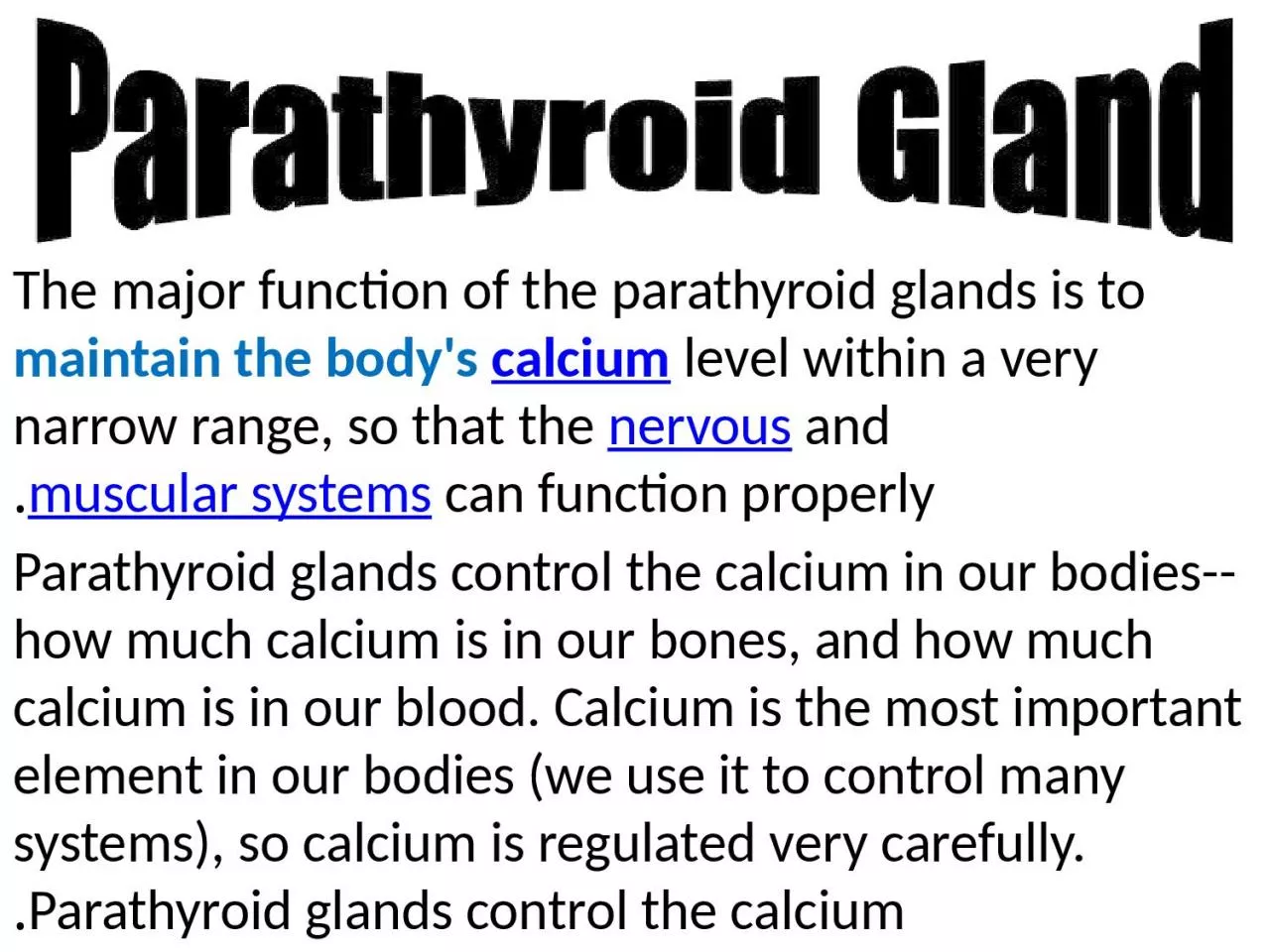

maintain the bodys calcium level within a very narrow range so that the nervous and muscular systems can function properly Parathyroid glands control the calcium in our bodieshow much calcium is in our bones and how much calcium is in our blood Calcium is the most important ele ID: 927766
Download Presentation The PPT/PDF document "The major function of the parathyroid gl..." is the property of its rightful owner. Permission is granted to download and print the materials on this web site for personal, non-commercial use only, and to display it on your personal computer provided you do not modify the materials and that you retain all copyright notices contained in the materials. By downloading content from our website, you accept the terms of this agreement.
Slide1
The major function of the parathyroid glands is to
maintain the body's calcium level within a very narrow range, so that the nervous and muscular systems can function properly.Parathyroid glands control the calcium in our bodies--how much calcium is in our bones, and how much calcium is in our blood. Calcium is the most important element in our bodies (we use it to control many systems), so calcium is regulated very carefully. Parathyroid glands control the calcium.
Slide2Parathyroid hormone
Parathyroid hormone (PTH) is secreted by the chief cells of the parathyroid glands as a polypeptide containing 84 amino acids. It acts to increase the concentration of calcium (Ca2+) in the blood
,
whereas
calcitonin (a hormone produced by the parafollicular cells (C cells) of the thyroid gland) acts to decrease calcium concentration.
Slide3Biosynthesis
1-Pre-Pro PTH: Consisting of 115 amino acids is first formed in polysomes,adhering on the rough ER membrane.2-Pro-PTH : Before the formation of Pre-Pro PTH is completed ,its N-terminal end products into the lumen of rough ER and a single peptidase of rough ER membrane hydrolyzes the molecule to split off 25 amino acid,and thus Pre-Pro PTH is changed to Pro-PTH having 90 amino acids.3-PTH : Pro-PTH is transferred to rough ER lumen and moves to Golgi cisternae.Thus PTH
formed is packaged and stored in secretary vesicles.
Slide4Regulation of PTH secretion
The stimulus for PTH secretion is hypocalcemia .There are three specific actions of PTH: 1-it stimulates release of calcium from bone by stimulating bone resorption. 2-PTH decreases the amount of calcium excreted in the urine, by stimulating calcium reabsorption in the kidney. Finally, PTH indirectly promotes calcium absorption
by the digestive tract, because it activates the enzyme in kidney cells that produces the hormone
1,25-(OH)
2D (the active form of vitamin D).
Slide5The sensor on the parathyroid gland cell that detects changes in the ECF calcium concentration is a
G-protein coupled receptor that is acalcium receptor. When ECF calcium is high, calcium binds to the receptor and this inhibits PTH secretion. When ECF calcium is low, the receptor is unbound and so there is no inhibition, and PTH secretion occurs.
Slide6Slide7Slide8PTH Effects on Bone
PTH has a rapid effect (occurring within minutes), whereby it stimulates osteoblasts to pump Ca++ ions out of the fluid surrounding the bone (which has a higher Ca++ concentration) and into the ECF. Over a longer time course, PTH stimulates bone resorption. PTH stimulation of osteoblasts causes them to express a signaling molecule that activates osteoclasts.
Slide9PTH Effects on Kidney
1-It decreases the loss of Ca++ ions in the urine by stimulating Ca++ reabsorption.As well as stimulating Ca++ reabsorption, PTH also inhibits phosphate reabsorption in the kidney.2-Stimulate production of 1,25(OH)2D, the active form of vitamin D. A precursor (known specifically as vitamin D3
or
cholecalciferol
) is synthesized in a photochemical reaction in the skin, in response to sunlight.
Slide10In kidney disease
Inadequate amounts of 1,25(OH)2D are made thus[Ca++](ECF) drops because of a lack of Ca++ absorption from the diet. Hypocalcemia stimulates high levels of PTH secretion; this is termed secondary hyperparathyroidism because the problem that causes the hyperparathyroidism is in the kidney, not at the parathyroid gland. Secondary hyperparathyroidism is treated by administering vitamin D and Ca++ supplements.
Slide11Stimulators
Decreased serum [Ca2+].Mild decreases in serum [Mg2+].An increase in serum phosphate (increased phosphate causes it to complex with serum calcium, forming calcium phosphate, which reduces stimulation of Ca-sensitive receptors (CaSr) that do not sense Calcium phosphate, triggering an increase in PTH).InhibitorsIncreased serum [Ca2+].Severe decreases in serum [Mg2+], which also produces symptoms of
hypoparathyroidism
(such as
hypocalcemia).
Slide12Mechanism of Action
Slide13Slide14Slide15Hyperparathyroidism
Primary hyperparathyroidism is the result of parathyroid gland disease, most commonly due to a parathyroid tumor (adenoma) which secretes the hormone without proper regulation. Secondary hyperparathyroidism is the situation where disease outside of the parathyroid gland leads to excessive secretion of parathyroid hormone. A common cause of this disorder is kidney disease - if the kidneys are unable to reabsorb calcium, blood calcium levels will fall, stimulating continual secretion of parathyroid hormone to maintain normal calcium levels in blood.
Slide16Slide17HypoparathyroidismInadequate production of parathyroid hormone typically results in decreased concentrations of calcium and increased concentrations of phosphorus in blood. Common causes of this disorder include surgical removal of the parathyroid glands and disease processes that lead to destruction of parathyroid glands. The resulting hypocalcemia often leads to tetany, and can be acutely life-threatening. Treatment focuses on restoring normal blood calcium concentrations by calcium infusions, oral calcium supplements and vitamin D therapy.
Slide18A test for
parathyroid hormone (PTH) is done to:1-Help identify hyperparathyroidism.2-Find the cause of an abnormal blood calcium level. 3- Check to see whether a problem with the parathyroid glands is causing the abnormal calcium level.
4-
Watch for problems in people who have
chronic kidney disease.